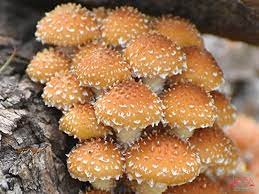Chestnut Mushroom Fruiting Conditions
Time To Colonize – 3-5 weeks – time to fruit 23-25 days – side fruit in bags
Chestnut mushrooms (Agrocybe aegerita) are a type of edible mushroom that can be grown both commercially and at home. The following conditions are ideal for fruiting chestnut mushrooms:
Temperature: They prefer temperatures between 60-75°F (16-24°C).
Humidity: High humidity levels, around 90-95%, are required for proper fruiting.
Light: Chestnut mushrooms do not require light for fruiting, but natural light can help regulate their growth cycle.
Substrate: A substrate of sterilized sawdust and hardwood chips is best for chestnut mushrooms.
Nutrients: Chestnut mushrooms require a balanced supply of nitrogen and carbon for proper growth and fruiting.

It is important to maintain these conditions consistently throughout the growing process to ensure the best results. Chestnut mushrooms can be challenging to grow, and it’s important to follow proper sterilization procedures to prevent contamination.
Buy A Chestnut Mushroom Grow Kit Today
Chestnut Mushroom Fruiting Temperature
The ideal fruiting temperature for Chestnut mushrooms is between 18-22°C (64-72°F). Chestnut mushrooms are a type of fungus that grows best in moderate temperatures, and they are highly sensitive to temperature fluctuations. Too low of a temperature can slow down or stop the fruiting process, while too high of a temperature can negatively impact the quality and flavor of the mushrooms. Consistent temperature control is important for successful Chestnut mushroom cultivation.
Check Out Our Chestnut Mushroom Spawn
Chestnut Mushroom Fruiting Humidity
The ideal fruiting humidity for Chestnut mushrooms is around 85-90%. Chestnut mushrooms require a high level of humidity to grow and fruit properly. Maintaining consistent humidity levels helps to prevent the fruit bodies from drying out, which can negatively impact the growth and quality of the mushrooms. Inconsistent humidity levels or sudden changes can also affect the fruiting process, so it’s important to monitor and adjust humidity levels as necessary during the growing process.
In addition to maintaining the proper humidity levels, it’s also important to provide adequate air exchange to prevent the buildup of harmful gases and microorganisms that can negatively impact the health and productivity of the Chestnut mushroom crop.
Try Our Chestnut Mushroom Ready to Fruit Blocks Now!
Chestnut Mushroom Fruiting Co2
The ideal fruiting CO2 level for Chestnut mushrooms is between 1,000-2,000 ppm. CO2 is a crucial component in the growth of mushrooms, as it helps to regulate their respiration and growth processes. However, excessively high CO2 levels can be harmful to Chestnut mushrooms, as well as other types of mushrooms. In general, it’s best to maintain consistent CO2 levels within the specified range to support the growth and fruiting of Chestnut mushrooms.
Chestnut Mushroom Fruiting Fresh Air Exchange (FAE)
Adequate fresh air exchange is also important for maintaining the proper CO2 levels, as well as for regulating the growth and fruiting of Chestnut mushrooms. The exact frequency of fresh air exchange can vary depending on the growing setup and environmental conditions, but it is typically recommended to exchange air 2-3 times per hour to support the health and productivity of the Chestnut mushroom crop.
Chestnut Mushroom Fruiting Lighting
Chestnut mushrooms are a type of fungus that does not require light for fruiting, as they do not produce chlorophyll like plants. However, adequate lighting is important for the overall health and growth of the Chestnut mushroom mycelium, as well as for regulating the circadian rhythm of the fungus.
In general, it is best to provide low to moderate indirect light, or to use artificial light sources, such as fluorescent lights, to supplement the light levels in the growing area. Direct sunlight can be harmful to the growth and quality of the mushrooms, so it’s important to avoid exposing them to excessive light levels.
If artificial lighting is used, it is best to provide light for 12-16 hours per day. The exact lighting conditions can vary depending on the growing setup and location, so it’s important to monitor and adjust the lighting as necessary to support the health and productivity of the Chestnut mushroom crop.
We Have Only The Best Chestnut Mushroom Liquid Culture Available

